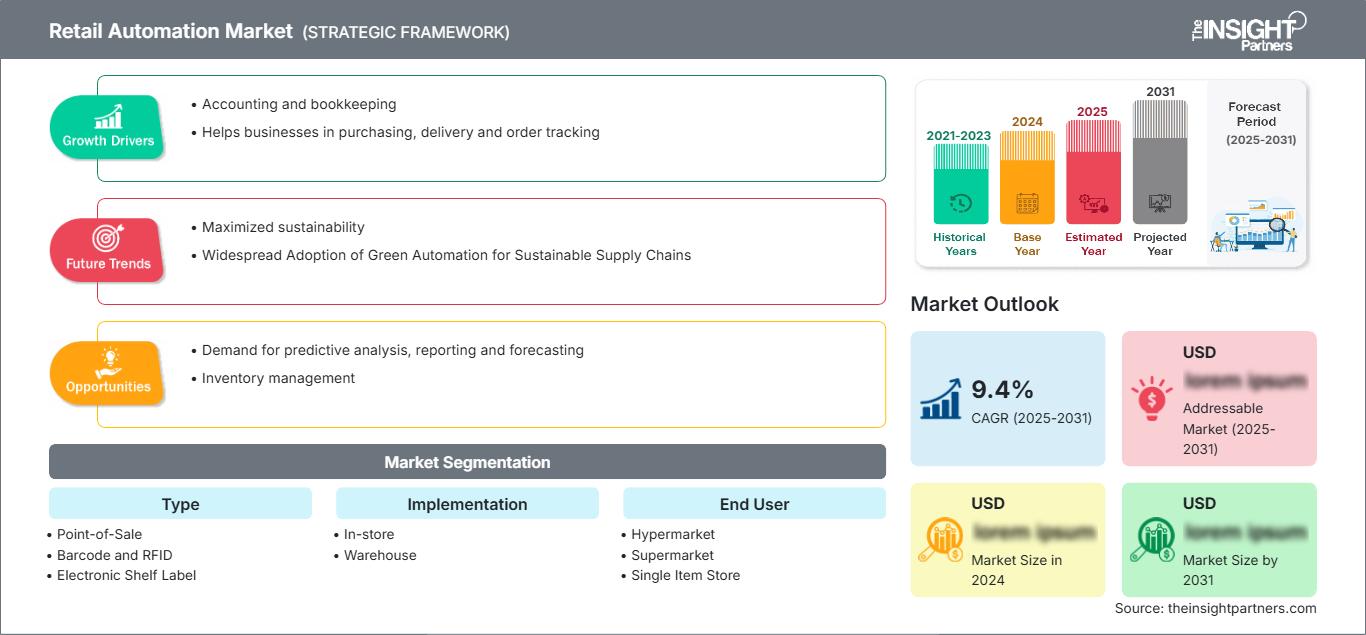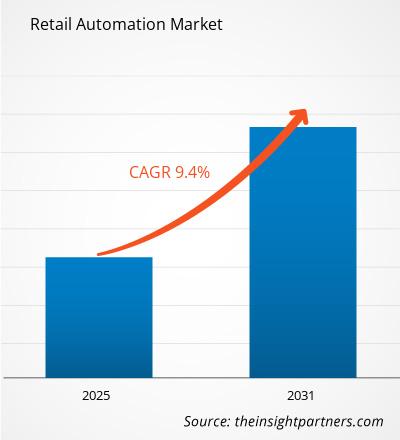Le marché de la vente au détail automatisée devrait enregistrer un TCAC de 9,4 % entre 2025 et 2031, avec une taille de marché passant de XX millions de dollars américains en 2024 à XX millions de dollars américains d'ici 2031.
Le rapport est segmenté par type (point de vente (POS), code-barres et RFID, étiquette électronique de gondole (ESL), caméra, véhicule à guidage autonome (AGV), autres) ; mise en œuvre (en magasin, entrepôt) ; utilisateur final (hypermarché, supermarché, magasin à article unique, station-service, pharmacie de détail, autres). L'analyse mondiale est ensuite ventilée au niveau régional et par principaux pays. Le rapport offre la valeur en USD pour l'analyse et les segments ci-dessus.
Objectif du rapport
Le rapport sur le marché de la vente au détail automatisé de The Insight Partners vise à décrire le paysage actuel et la croissance future, les principaux facteurs moteurs, les défis et les opportunités. Cela fournira des informations à diverses parties prenantes commerciales, telles que :
- Fournisseurs/fabricants de technologie : pour comprendre l’évolution de la dynamique du marché et connaître les opportunités de croissance potentielles, leur permettant de prendre des décisions stratégiques éclairées.
- Investisseurs : pour effectuer une analyse complète des tendances concernant le taux de croissance du marché, les projections financières du marché et les opportunités qui existent tout au long de la chaîne de valeur.
- Organismes de réglementation : pour réglementer les politiques et surveiller les activités du marché dans le but de minimiser les abus, de préserver la confiance des investisseurs et de maintenir l’intégrité et la stabilité du marché.
Type de segmentation du marché de détail automatisé
- Point de vente
- Code-barres et RFID
- Étiquette électronique de gondole
- Caméra
- Véhicule à guidage automatique
- Autres
Mise en œuvre
- En magasin
- Entrepôt
Utilisateur final
- Hypermarché
- Supermarché
- Magasin à article unique
- Station-service
- Pharmacie de détail
- Autres
Géographie
- Amérique du Nord
- Europe
- Asie-Pacifique
- Amérique du Sud et centrale
- Moyen-Orient et Afrique
Vous bénéficierez d’une personnalisation sur n’importe quel rapport - gratuitement - y compris des parties de ce rapport, ou une analyse au niveau du pays, un pack de données Excel, ainsi que de profiter d’offres exceptionnelles et de réductions pour les start-ups et les universités
Marché de l'automatisation de la vente au détail: Perspectives stratégiques

- Obtenez les principales tendances clés du marché de ce rapport.Cet échantillon GRATUIT comprendra une analyse de données, allant des tendances du marché aux estimations et prévisions.
Facteurs de croissance du marché de détail automatisé
- Comptabilité et tenue de livres : l'automatisation de la comptabilité permet des gains de temps, une productivité accrue pour les comptables, des données plus précises, une récupération plus rapide des données et un stockage sécurisé. Ces améliorations aident les entreprises à éviter les erreurs coûteuses et à faire gagner du temps à leurs services financiers.
- Aide les entreprises pour les achats, la livraison et le suivi des commandes : l'automatisation permet aux utilisateurs de soutenir les équipes internes en instaurant la confiance et la fidélité des clients. L'automatisation des expéditions allège également la charge de travail de l'équipe en supprimant ou en simplifiant les opérations répétitives et subalternes.
Tendances futures du marché de détail automatisé
- Durabilité maximale : les pratiques écologiques des entreprises sont bénéfiques pour l'environnement et peuvent jouer un rôle important dans l'augmentation de la confiance des clients et de la rentabilité. L'automatisation a rendu les pratiques durables plus accessibles, permet aux détaillants d'automatiser les opérations d'expédition et de transport en réduisant les déchets et les achats inutiles, et améliore le rendement énergétique.
- Adoption généralisée de l'automatisation verte pour des chaînes d'approvisionnement durables : L'avenir verra une attention accrue portée à la maximisation de la durabilité grâce à l'adoption de l'automatisation verte dans les chaînes d'approvisionnement. Les technologies avancées, telles que l'optimisation des itinéraires basée sur l'IA et la robotique économe en énergie, aideront les entreprises à réduire leur empreinte carbone, à minimiser les déchets et à améliorer l'utilisation des ressources. Cette évolution améliorera non seulement l'impact environnemental, mais stimulera également la rentabilité et la fidélisation des clients en répondant à la demande croissante de pratiques durables dans les secteurs de la vente au détail et de la logistique.
Opportunités du marché de la vente au détail automatisée
- Demande d'analyse prédictive, de reporting et de prévisions : L'analyse prédictive est un élément de l'automatisation de la vente au détail qui contribue à améliorer l'expérience client. Cette forme d'analyse de données permet aux entreprises de prédire les ventes futures et d'éviter toute pénurie de produits. L'analyse prédictive peut également personnaliser l'expérience client en prévoyant les articles populaires et les tendances.
- Gestion des stocks : La gestion des stocks est essentielle au développement d'une entreprise de vente au détail. Un stock insuffisant peut ne pas répondre à la demande des clients, tandis qu'un stock excessif peut entraîner la péremption des produits ou les rendre obsolètes par rapport aux tendances de consommation. L'automatisation peut améliorer la visibilité des stocks, les tendances de consommation, les prévisions saisonnières ou mensuelles des stocks et le suivi des ventes. Les entreprises qui automatisent leurs processus de gestion des stocks peuvent réduire les pertes de produits, augmenter les ventes et améliorer l'expérience client.
Aperçu régional du marché de l'automatisation de la vente au détail
Les tendances régionales et les facteurs influençant le marché de l'automatisation du commerce de détail tout au long de la période de prévision ont été analysés en détail par les analystes de The Insight Partners. Cette section aborde également les segments et la géographie du marché de l'automatisation du commerce de détail en Amérique du Nord, en Europe, en Asie-Pacifique, au Moyen-Orient et en Afrique, ainsi qu'en Amérique du Sud et en Amérique centrale.
Portée du rapport sur le marché de l'automatisation de la vente au détail
Attribut de rapport Détails Taille du marché en 2024 US$ XX million Taille du marché par 2031 US$ XX Million TCAC mondial (2025 - 2031) 9.4% Données historiques 2021-2023 Période de prévision 2025-2031 Segments couverts By Type - point de vente
- code-barres et RFID
- étiquette électronique de gondole
- caméra
- véhicule à guidage autonome
- autres
- en magasin
- en entrepôt
- hypermarché
- supermarché
- magasin d'articles uniques
- station-service
- pharmacie de détail
- autres
- Amérique du Nord
- Europe
- Asie-Pacifique
- Amérique du Sud et centrale
- Moyen-Orient et Afrique
Régions et pays couverts Amérique du Nord - États-Unis
- Canada
- Mexique
- Royaume-Uni
- Allemagne
- France
- Russie
- Italie
- reste de l'Europe
- Chine
- Inde
- Japon
- Australie
- reste de l'Asie-Pacifique
- Brésil
- Argentine
- reste de l'Amérique du Sud et centrale
- Afrique du Sud
- Arabie saoudite
- Émirats arabes unis
- reste du Moyen-Orient et de l'Afrique
Leaders du marché et profils d'entreprises clés - Fujitsu Corporation
- Honeywell International Inc.
- KUKA AG
- Toshiba Corporation
- Datalogic S.P.A.
- ZIH Corp.
- Future Way Technical Services LLC
- Pricer
- Teraoka Seiko Co., Ltd.
Densité des acteurs du marché de l'automatisation du commerce de détail : comprendre son impact sur la dynamique des entreprises
Le marché de l'automatisation du commerce de détail connaît une croissance rapide, portée par une demande croissante des utilisateurs finaux, due à des facteurs tels que l'évolution des préférences des consommateurs, les avancées technologiques et une meilleure connaissance des avantages du produit. Face à cette demande croissante, les entreprises élargissent leur offre, innovent pour répondre aux besoins des consommateurs et capitalisent sur les nouvelles tendances, ce qui alimente la croissance du marché.

- Obtenez le Marché de l'automatisation de la vente au détail Aperçu des principaux acteurs clés
- Analyse historique (2 ans), année de base, prévision (7 ans) avec TCAC
- Analyse PEST et SWOT
- Taille du marché Valeur / Volume - Mondial, Régional, Pays
- Industrie et paysage concurrentiel
- Ensemble de données Excel
Rapports récents
Témoignages
Raison d'acheter
- Prise de décision éclairée
- Compréhension de la dynamique du marché
- Analyse concurrentielle
- Connaissances clients
- Prévisions de marché
- Atténuation des risques
- Planification stratégique
- Justification des investissements
- Identification des marchés émergents
- Amélioration des stratégies marketing
- Amélioration de l'efficacité opérationnelle
- Alignement sur les tendances réglementaires




















 Obtenez un échantillon gratuit pour - Marché de l'automatisation de la vente au détail
Obtenez un échantillon gratuit pour - Marché de l'automatisation de la vente au détail